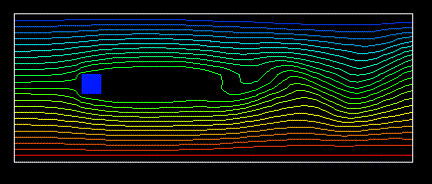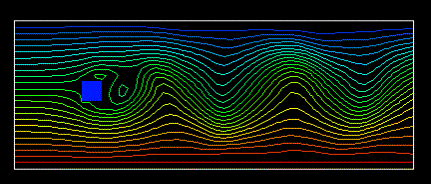Hybrid wind tunnel
integrated numerical simulation and experimenta
measurement
The ordinary flow analisys methods are experimental measurement and numerical simulation. Each has both advantages and disadvantages, so it has used selectively or complementaly. Hybrid wind tunnel is a new analysis method, which is integrated experimental measurement and numerical analysis. In this method, flow field is computed using the feedback technique according to the difference between properties in the experiment and the numerical simulation. The result shows properties close to the experimental data in the whole flow field at real time. Then, no special measurement devices such as particle, laser, camera, need to get the properties. Also it is expected to analyze immeasurable flow field by other methods and evolve to feedback control of flow field under favor of real time system.
animation
Fig.1 Flow field of karman vortex (experiment)The left figure shows the experimental flow field of Karman vortex with smoke visualization. The pressure on the upper and lower side of the square cylinder is measured and it it transported to the super computer.
It is feedbacked to the numerical simulation on the supercomputer.
animation
Fig.2 Numerical Flow field
(Without feedback)
Left figure shows the numerical simulation result without feedback. This simulation has relatively coarse grid systems. So it represents weak vortex sheeding effect and can't represents vortex generated behind the square cylinder.
animation
Fig.3 Numerical Flow field
(With feedback)
The left figure shows the flow field with feedback.
With using coarse grid same as above, it represents the strong vortex seeding effect and vortex behind the square cylinder.
With increasing of computation performance, it can represents the flow field synclonizing with the real flow.
・Refference
T. Hayase and S. Hayashi:State Estimator of Flow as an Integrated Computational Method with the Feedback of Online Experimental Measurement,Transactions of the ASME, Journal of Fluids Engineering, Vol. 119 No. 4 (1997), pp. 814 - 822.


